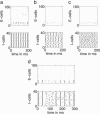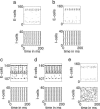Background gamma rhythmicity and attention in cortical local circuits: a computational study
- PMID: 15870189
- PMCID: PMC1100794
- DOI: 10.1073/pnas.0502366102
Background gamma rhythmicity and attention in cortical local circuits: a computational study
Abstract
We describe a simple computational model, based on generic features of cortical local circuits, that links cholinergic neuromodulation, gamma rhythmicity, and attentional selection. We propose that cholinergic modulation, by reducing adaptation currents in principal cells, induces a transition from asynchronous spontaneous activity to a "background" gamma rhythm (resembling the persistent gamma rhythms evoked in vitro by cholinergic agonists) in which individual principal cells participate infrequently and irregularly. We suggest that such rhythms accompany states of preparatory attention or vigilance and report simulations demonstrating that their presence can amplify stimulus-specific responses and enhance stimulus competition within a local circuit.
Figures




References
-
- Gruber, T., Müller, M. M., Keil, A. & Elbert, T. (1999) Clin. Neurophysiol. 110, 2074–2085. - PubMed
-
- Herrmann, C. S. & Mecklinger, A. (2001) Visual Cognit. 8, 593–608.
-
- Maloney, K. J., Cape, E. G., Gotman, J. & Jones, B. E. (1996) Neuroscience 76, 541–555. - PubMed
-
- Tiitinen, H., May, P. & Näätänen, R. (1997) Prog. Neuropsychopharmacol. Biol. Psychiatry 21, 751–771. - PubMed
Publication types
MeSH terms
Grants and funding
LinkOut - more resources
Full Text Sources

